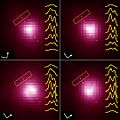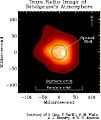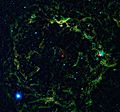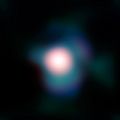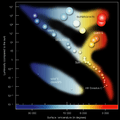Betelgeuse facts for kids
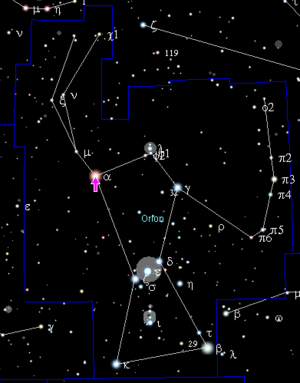

Betelgeuse is a huge red supergiant star found in the Orion constellation. Its name comes from an Arabic phrase meaning "the armpit of Orion." It's usually the ninth-brightest star we can see in the night sky and the second-brightest in Orion.
Betelgeuse is a special type of star called a variable star. This means its brightness changes over time. Its brightness can go up and down quite a bit, more than any other very bright star.
It's also one of the biggest and brightest stars we can see from Earth. Imagine our Sun; Betelgeuse is about 950 to 1,000 times wider! That means it's over a billion kilometers (or 800 million miles) across. Betelgeuse was the first star, besides our Sun, whose actual size scientists were able to figure out. It's about 640 light-years away from Earth. A light-year is how far light travels in one year, which is a very long distance!
Betelgeuse is zooming through space at about 30 kilometers (18.6 miles) per second. As it moves, it creates a huge shock wave in space, which is like a ripple, that's more than 4 light-years wide! In 2013, the Herschel Space Observatory saw that the strong winds from Betelgeuse were bumping into small objects in space. Betelgeuse is one of the few red supergiant stars known to have a "bow shock," which is a shock wave shaped like the front of a boat.
Because Betelgeuse is so massive, it's changing very quickly. It's currently in a late stage of its life cycle. This means it will finish its life cycle faster than smaller stars. Scientists expect it will eventually explode in a huge blast called a Type II supernova.
You can easily spot Betelgeuse in the Orion constellation as the bright star at the upper left, which looks like Orion's shoulder.
Contents
Cool Facts About Betelgeuse
- Betelgeuse shines about 7,500 to 14,000 times brighter than our Sun.
- If Betelgeuse were in place of our Sun, it would be so big that it would reach past the orbit of Jupiter!
- The surface of Betelgeuse is about 3,300 degrees Celsius (6,000 degrees Fahrenheit). That's hot, but it's actually about 4,000 degrees cooler than the Sun's surface.
- In 1836, a famous astronomer named Sir John Herschel was the first to write down that Betelgeuse's brightness was changing.
- Betelgeuse became much fainter than usual for several months in late 2019 and early 2020. But by April 2020, it was back to its normal brightness.
- Betelgeuse was the first star, besides our Sun, whose photosphere (its visible surface) was measured.
Other Names for Betelgeuse
Betelgeuse is also known as Alpha Orionis (α Orionis, or Alpha Ori, α Ori for short).
Stars You Might Also Like
- Orion (constellation)
- Rigel
- 119 Tauri, Antares, and Mu Cephei are other red supergiant stars similar to Betelgeuse.
Images for kids
-
Sir John Herschel in 1846
-
Images from the Hubble Space Telescope in 1998 and 1999 showing how Betelgeuse changes shape.
-
A graph from the American Association of Variable Star Observers showing Betelgeuse's brightness from September 2018 to February 2021.
-
The NRAO's Very Large Array helped figure out Betelgeuse's distance in 2008.
-
Orion with Betelgeuse at its usual brightness (left) and when it was unusually dim in early 2020 (right).
-
A picture comparing the sizes of Betelgeuse, Mu Cephei, KY Cygni, and V354 Cephei.
-
An image from the ESO's Very Large Telescope showing the star's disk and a plume of gas around it.
-
An outside view of ESO's Very Large Telescope (VLT) in Paranal, Chile.
-
A Hertzsprung–Russell diagram which helps scientists understand how stars like Betelgeuse change over time.
-
What Orion might look like from Earth when Betelgeuse explodes as a supernova. It could be even brighter than the supernova seen in 1006!
-
An old drawing of Orion from a book by Abd al-Rahman al-Sufi. Betelgeuse is labeled as "Hand of Orion" and "Shoulder of Orion."
See also
 In Spanish: Betelgeuse para niños
In Spanish: Betelgeuse para niños



